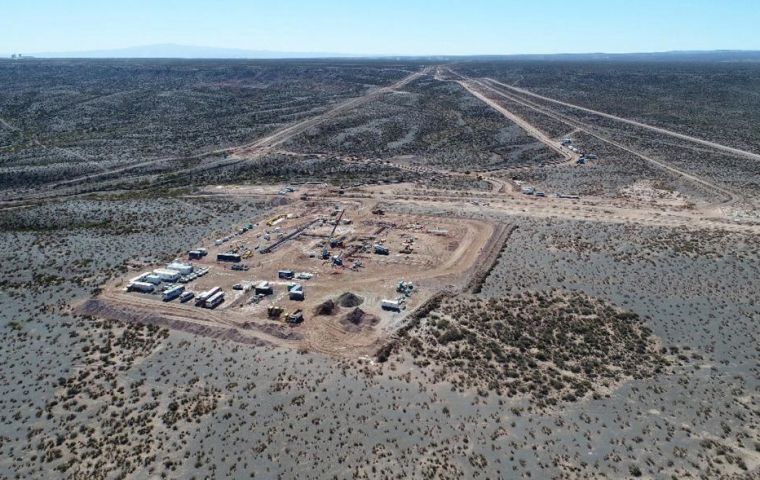MercoPress. South Atlantic News Agency
Argentina's shale boom at Vaca Muerta seems to be finally taking off
 Vaca Muerta has been one of the few bright spots in shale gas production outside United States, but it hasn’t come even close to replicating the U.S. shale revolution
Vaca Muerta has been one of the few bright spots in shale gas production outside United States, but it hasn’t come even close to replicating the U.S. shale revolution By Tsvetana Paraskova for Oilprice.com - After years of drilling and development and billions of U.S. dollars of investment, Argentina’s vast shale play Vaca Muerta has finally seen the first tangible results with the first exports of light crude oil and liquefied natural gas (LNG) from the resource-rich formation.
Apart from Argentina’s oil and gas group YPF, international oil and gas majors including Exxon, Chevron, Shell, and Total hold acreage positions in Vaca Muerta and have recently announced plans to proceed with major development projects in the most promising shale oil and gas basin outside the United States.
The first oil and natural gas exports in recent weeks, however, signal that the years of development and the billions of dollars may finally start to pay off and make Argentina a net oil and gas exporter again
Big Oil’s continued commitment to Vaca Muerta is also a sign that the huge potential of Argentina’s prime shale play can be tapped and turned into sizeable production volumes.
Vaca Muerta, Spanish for ‘dead cow’, has been dubbed the ‘Argentine Permian’, although its geologic properties have been compared to the Eagle Ford.
Vaca Muerta has been one of the few bright spots in shale gas production outside the United States, but it hasn’t come even close to replicating the U.S. shale revolution.
Now developers are turning their attention to exporting natural gas and to tapping more oil in the Vaca Muerta formation.
Earlier this month, YPF exported its first ever LNG cargo with natural gas extracted from the Vaca Muerta. This is the first step of YPF’s gas exports to the world, Marcos Browne, Executive Vice President of Gas and Energy at YPF, said.
YPF boosted its shale oil and gas production by 45% annually to 71,000 barrels of oil equivalent per day (boepd) in the first quarter of 2019, thanks to three massive projects in Vaca Muerta—Loma Campana, La Amarga Chica, and Bandurria Sur, the state-controlled company said in its Q1 results release.
Super-major Shell said in December that it was moving into the development phase of the Sierras Blancas, Cruz de Lorena, and Coiron Amargo Sur Oeste blocks in Vaca Muerta, with full-scale development with the potential to deliver more than 70,000 boepd by the mid-2020s.
“Vaca Muerta makes up an important part of our global shale portfolio and we see substantial long-term growth potential there,” Shell Upstream Director Andy Brown said.
The increased commitment to oil development at Vaca Muerta is expected to change Argentina’s energy profile from one of oil importer to oil exporter, Shell’s head in Argentina Sean Rooney told Bloomberg.
“And that’s going to grow over time. It’s going to be some hundreds of thousands of barrels a day,” Rooney added.
Other majors are also scaling up development and production plans in the prized Argentine shale play. Earlier this month, Exxon said that it plans to drill 90 wells in the Vaca Muerta, with first-phase peak production expected to reach 55.000 oil equivalent barrels per day in five years.
According to Wood Mackenzie’s recent tour of fields in the area, well productivity is improving, and companies expect that productivity to rise by 25% as soon as in 2020.
“Although the focus is to boost production, the shift towards the shale oil window was evident, hitting the brakes on the rapid increase in gas production,” WoodMac said in a report earlier this month.
It looks like everything is falling into place for Argentina’s shale boom to finally take off. However, two key hurdles remain to making the Vaca Muerta an oil and gas production powerhouse like the U.S. shale plays.
One is not enough infrastructure, and the other is an upcoming presidential election in October in which incumbent President Mauricio Macri will be running against an opposition team in which former populist president Cristina Fernandez de Kirchner, who ran an interventionist energy policy until 2015, is running for vice-president.
Pro-business Macri could continue his reforms to liberalize the energy sector, but Argentina’s struggling economy could hurt his chance of being re-elected in the fall.
In terms of infrastructure, Macri announced two weeks ago that Argentina would launch in July a tender for a major pipeline to service the Vaca Muerta, but analysts say that even more pipelines and other infrastructure would be needed for Argentina to become a major exporter of oil and gas.
Argentina could become a major LNG supplier to Asian markets because Argentina’s peak LNG potential in the southern hemisphere’s summer coincides with strong demand in Asia in the northern hemisphere’s winter, Wood Mackenzie said this month.
Moreover, Argentine LNG would have lower shipping costs to reach Asian markets than liquefaction plants on the U.S. Gulf Coast, because shipments from Argentina would avoid potential congestions at the Panama Canal, “presenting an overall cheaper alternative to US exports,” according to WoodMac.
“LNG exports could be a solution that enables Vaca Muerta’s production to continue the growth story,” said Mauro Chavez Rodriguez, principal analyst, Latin America Gas & LNG, at Wood Mackenzie.




Top Comments
Disclaimer & comment rulesCommenting for this story is now closed.
If you have a Facebook account, become a fan and comment on our Facebook Page!